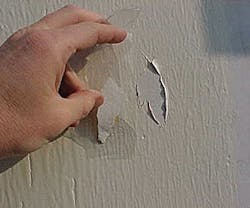Top 3 Problems with Exterior Coatings and Paints
While recoating your exterior may seem simple on the surface, it’s actually a complicated process that requires specifications, ratings, and tests. When you cover existing problems without remedying them first, you could be painting yourself into a costly corner.
If you avoid the three most common problems with coatings, your job could last for 10 years or longer – and then you’ll feel like painting the town red.
1) Improper Surface Preparation
The first step in picking your next coating is to analyze the current situation.
“Product selection really depends on the building you have, substrate type and condition, and long-term goals,” says Brock Osborn, business development manager of reStore, the restoration program of Sto Corp., a cladding and coating systems manufacturer.
“Regardless of substrate type – EIFS, stucco, or masonry – make sure the envelope is sound,” adds Leta Hardy, vice president of business development for Valcourt Building Services, a waterproofing and restoration firm. “Don’t skimp on making it watertight first and foremost. That will help you reach your goal for longevity.”
Cracks indicate the possibility for moisture penetration and must be sealed. It only makes sense to use a coating if the envelope is waterproofed and repaired. “You’re looking for a pinhole-free finish,” explains Hardy.
An equally important consideration to the substrate is the existing coating, which may not always be the right material to use again.
“People tend to fall back on what’s easy, and that’s going out and throwing on another coat of whatever’s already there,” explains Osborn. “Applying layer after layer will make permeation fall to zero, and you reach a tipping point where water vapor can’t pass through and you start to see blistering and bubbling.”PageBreak
2) Wrong Material for the Application
In order to specify the right coating, there are several American Society for Testing and Materials (ASTM) standards to take into account.
Consultants and specifying engineers can help identify the ratings that pertain to the circumstances. It’s important to ask manufacturers and contractors if these standards are being met on your project.
“You want to be aware of these ratings and somewhat well-versed in them regardless of substrate or coating type, because they level the playing field,” Osborn explains. “Make sure you know the product’s make-up.”
Properties covered by ASTM standards include elongation, elongation recovery, permeability, and resistance to wind-driven rain, says Christopher Perego, industry sector manager of parking and restoration for chemical manufacturer BASF.
Elongation is an important consideration for elastomeric coatings because they are used to bridge cracks and hairline fractures that fluctuate slightly throughout the day.
“Make sure manufacturers also mention recovery, because the ability of a coating to return to its original dimension is just as important as its ability to expand over existing cracks,” Perego adds.
Elastomeric coatings are only necessary when cracks are present, Perego says, noting that high build acrylic coatings will often suffice.
Before applying the coating in mass, make sure engineers or contractors take a couple of performance tests, advises Perego.
One involves gluing a hockey puck-sized button to the coated substrate, putting pressure onto it with a crank-like tripod device, and pulling it off to observe where failure occurs.
The other, commonly called a “tape test,” involves scoring a 2- by 2-inch X in the coating, covering it with packing or duct tape, and pulling the tape off while looking for delamination.
3) Improper Application of the Coating
Ratings and tests will tell you what to apply, but equally important is how it’s applied.
“You want to ensure that the work being performed meets the requirement for a warranty to be awarded at the finish of the project,” explains Hardy, adding that going with the lowest bidder can be a recipe for disaster.
“The contractor makes all the difference in the world,” agrees Osborn. “Look for contractors that are members of trade organizations, like the Sealant Waterproofing and Restoration Institute (SWRI) and the Painting and Decorating Contractors of America (PDCA).”
It can also be helpful to ask the manufacturer about contractors within their network, says Hardy.
“Local design professionals also tend to know who the best contractors are, and one of the best things to do is ask for references that include buildings similar to yours,” says Perego. “Coating a building may seem straightforward, but making a mistake can lead to expensive repairs of the repair.”
Chris Curtland [email protected] is assistant editor of BUILDINGS.
